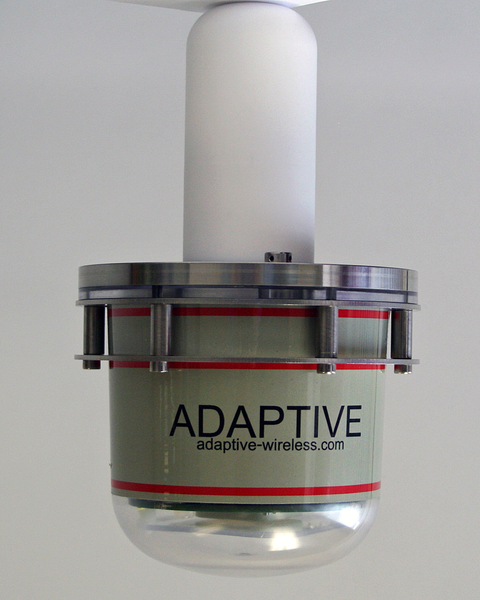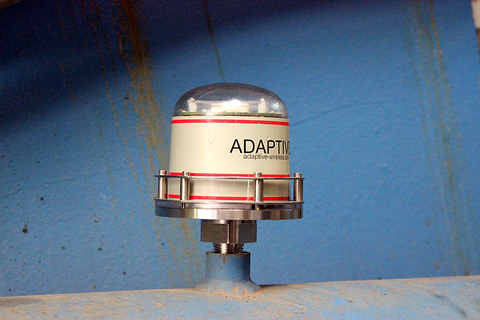
Wireless instruments provide critical information on physical processes such as temperature, pressure, level, flow and humidity to wireless sensing networks, including WirelessHART, ISA100, ZigBee and other 802.15.4 networks. Used to monitor the operating conditions and health of industrial equipment from engines to motors, pumps, valves, and compressors, wireless instrumentation is often used in conjunction with control systems as well as for predictive and preventative maintenance programs.
However, despite playing such a key role, these devices are often expensive, difficult and time consuming to install. This extends both to “physical” issues such as initial set-up requirements and location of the antenna, to information security and connection with the gateway network. In addition, ongoing support, upgrades, and device/battery replacement often equal, and even exceed, initial installation costs.
According to David Lafferty, who as former Chief Technology Officer at BP was involved in the early development of industrial wireless, the high costs of deployment and support are the primary barriers preventing industrial wireless from reaching its full potential. “If you look back to when WirelessHART was initially launched 13 years ago, we thought there would be more large scale wireless deployments by now,” says Lafferty.
A more realistic, real-world example today is, “three wireless temperature sensors at the other side of a parking lot because they didn’t want to tear it up; as opposed to ‘I have 10,000 instruments in my plant and three are wired.’ This is backwards,” says Lafferty.
Today, the drive to reduce the costs of wireless deployment is spurring a re-evaluation of the design of such devices, which has changed little in the past decade. As a result, new options on the market now address some of the fundamental deficiencies of these devices. This includes separating the sensor from the antenna so it can be placed at a distance for ideal signal transmission; a vastly simplified user interface allowing for installation in minutes; along with built-in, world-class security features.
Simplifying Deployment
In many cases, wireless instruments are used in hazardous environments so they need to be certified as intrinsically safe (IS) or explosion-proof (XP). Given the hazardous environment in plants, installing these instruments should be as simple and quick as possible for safety reasons, as well as to minimize time and disruption within the plant.
Unfortunately, traditional wireless instrumentation has a notoriously poor user interface that often involves tiny LCD displays and small membrane switches that are difficult to utilize in the field. The degree of difficulty increases when the devices are high up on equipment, buried deep in pipework or manipulated by installers wearing gloves.

Even the simple task of entering “join” key codes used to authenticate wireless field devices joining the network can be difficult. With traditional wireless sensors, this can involve entering 32 or 56 characters into a small handheld device with security features that obscure characters already entered. According to Lafferty, the “ease of use” concept should not be minimized, given the fact that the industry is losing a large percentage of its installed base to retirement.
Today, younger, less experienced and often less trained personnel are simply not used to reading the instruction manual to see how products work and should be installed. As a result, even seemingly minor design features can simplify installation.
In reality, displays or small buttons are not mandatory if the wireless instrument is properly designed. Nor are dedicated ports for connecting to external communications devices that essentially substitute for the display/buttons, and cost thousands of dollars. Lafferty points to the wireless instruments offered by longtime manufacturer Adaptive Wireless Solutions, which do not have a display, membrane switches or external ports. Instead, all interaction occurs through a web browser on a cell phone or tablet. This is possible because the instruments work on their own Wi-Fi network, which is only utilized for tasks like configuration to conserve battery power.
For the unit itself, the application of a push on the housing (like honking the horn on a steering wheel) and LED lights used for visual confirmation of connection are all that is required to add instruments to the network. Even when replacing a unit, this task takes only about 15 seconds. With traditional models, it can take hours to days. “When you are talking about a project to deploy 5,000 sensors, if you can shave two hours off each sensor deployment at $85/hour per installer, it adds up very quickly,” says Lafferty.
The Antenna Dilemma
Another installation issue involves the placement of the antenna. With traditional wireless instruments, the sensor and antenna are typically combined in a single device that must be installed at the point of measurement. This often means the antenna is in a location with poor line-of-sight to the WSN. For this, Adaptive Wireless Solutions redesigned its instrument to be separated into two parts: the end node with highly accurate sensors at the read point, and the central controller, which contains the antenna.

The ability to move the central controller some distance from the end node, wirelessly, allows for better signal reception/transmission within the plant. Up to eight end nodes can be connected to a single central controller using a Bluetooth low energy (BLE) radio link that is controlled to minimize power usage. The central controller then communicates back to the WSN network. With this design approach, end nodes can be moved or added behind the central controller without the WSN being affected.
This stands in stark contrast with the traditional approach, where all instruments are connected directly to the WSN and so consume resources including power and address space; limited numbers of nodes per gateway, for instance. Because most networks like WirelessHART involve a mesh architecture designed for resiliency and redundancy of communication paths, adding nodes increases the number of possible paths dramatically (square law). This can get out of control rapidly, slowing installation and creating network instability.
Managing Support Costs
Once the wireless instruments are installed, ongoing support, upgrades and battery placement can significantly increase overall costs. “The ongoing costs are really coming to light as existing wireless instruments in the field are now getting to the point where it needs updating or replacing,” says Lafferty. “In many cases, it can cost the same as the initial deployment.”
Ideally, installers want to treat these devices like a light bulb: when it burns out, just replace it. However, firmware updates and current settings stored in the device are often lost when a node is removed or fails. In a more elegant solution, Adaptive Wireless can clone the configuration of any member of the central controller group, even after the node is removed or even destroyed.
To accomplish this, configuration information is stored in all other nodes, redundantly, and so can be reconstituted or cloned by simply transferring the data. So long as one device within the cluster is intact the others can be quickly and easily reconstructed in the field. “Adaptive Wireless has the ability to clone the entire configuration of the device so that the new instrument is an exact clone,” explains Lafferty.
Wireless updates and frugal use of power have been so carefully designed such that batteries don’t need replacing – the unit grows old before the battery dies - further reducing the cost and complexity of replacing devices. “With the cost of ongoing maintenance dramatically reduced, [wireless instrumentation] is now a solution that can be scaled up to the kinds of numbers needed for the digitalization effort happening in many industries,” adds Lafferty.
This includes the Industrial Internet of Things (IIoT), for which Lafferty is currently doing business development and consulting through his company Scientific Technical Services. The IIoT utilizes wireless instrumentation and other types of installed sensors to collect and share information with other parts of the system where machines essentially learn from other machines. By doing so, manufacturers expect to identify inefficiencies, remove bottlenecks and streamline operations to become more competitive and profitable.
“The Industrial Internet of Things is about getting around the cost and complexity of conventional deployment,” says Lafferty. “So, efforts to streamline the installation and integration of wireless instrumentation are critical to those efforts as well.”
About the author
Jeff Elliott is a Torrance, Calif.-based technical writer. He has researched and written about industrial technologies and issues for the past 20 years. For more information, contact Adaptive Wireless Solutions at (978) 875-6000; write 577 Main Street, Hudson, MA 01749; or visit www.adaptive-wireless.com.